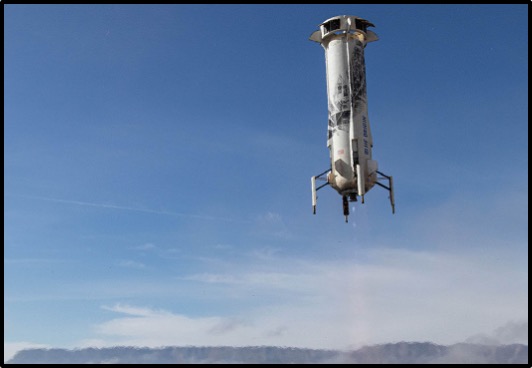Billionaire Jeff Bezos was one of the first to take advantage of the flaws of the aerospace sector when he founded Blue Origin on September 8th, 2000—a company that created aerospace technologies suitable for low-earth orbit travel. Blue Origin’s New Shepard is a developing commercial rocket that is capable of sending passengers to the frontier of space and returning back to solid ground. Its ability to return to Earth has made New Shephard far more efficient than any small rocket NASA has created; sending a rocket to space is a difficult task, but making it return back to Earth is far more rigorous. Reusability is what makes anything efficient—once full reusability is gained in space travel, access to the final frontier will begin opening to the public.
On July 24th, 1969 the U.S. sent the first astronauts to the moon via the Apollo program—one of the biggest accomplishments in history. This was due to the insane engineering of NASA’s Saturn V rocket—the most sophisticated and powerful rocket ever built. This feat of excellence had a massive payload capacity and never had any malfunctions when in use, thus it was used time and time again to send the Apollo spacecraft to orbit; later on the Saturn V brought Skylab into Earth’s orbit due to its effectiveness and carrying capacity. After the Space Race—the event between the Soviet Union and the U.S that began the incentive to go to space—there was a large period of silence in terms of space exploration. This was because the need for going to space in an efficient manner was not possible—rockets used a ridiculous amount of fuel to get into orbit, and launching these rockets was extremely expensive;. Nevertheless, the most inefficient part about space travel was that all the rockets that were used weren’t reusable—most parts were left to drift into the abyss of space or simply burnt to a crisp whilst entering Earth’s atmosphere, tens of millions of taxpayer dollars were wasted on one-use rockets. The obvious answer to these issues was to develop fully-reusable rockets that could be reliably used for almost any type of mission. NASA created the Space Shuttle in order to quell this issue—although it was quite unsuccessful. Failure was due to NASA relying on parts from too many different organizations—thus the price of the Space Shuttle was extremely steep to both construct and launch into space. This problem was soon to be resolved by Blue Origin with the New Shepard rocket, but also by a far more successful space agency—SpaceX.

Blue Origin’s New Shepard rocket landing back on the Earth’s surface
SpaceX is another private space organization formed by a billionaire—Elon Musk. Like Bezos, Musk realized the downsides of current space travel, and so he formed SpaceX on May 6th, 2002 to quell this issue. Musk’s company began rapid testing engine designs that could be used on a future fully-reusable rocket; their tests left them with an engine that suited their needs. On June 4th, 2010, the first Falcon rocket was launched—spurring countless more launches by SpaceX. The reason that this was possible as a private company without government funding was because all parts of the rocket were produced by SpaceX, thus lowering the overall cost by an extreme amount. As of today SpaceX is well known for having one of the most successful rocket designs, they send rockets into space several times a month—not a single casualty has occured due to the rigorous testing Musk’s company has put their rockets under. But Blue Origin and SpaceX aren’t the only private companies beginning to privatize the space sector; some other companies include Relativity Space, Ariane Space, and Rocket Lab—all of these companies are far smaller than Blue Origin and SpaceX, but are all making headway to producing smaller fully-reusable rockets that are capable of sending small payloads to orbit.
The reason NASA, a government-funded agency, wasn’t anywhere close as successful as the private sector was due to their lack of competition after the Space Race. But now since everyone is rushing to space, people are one-upping each other with designs that make space travel far better than it has ever been. Focusing on one central idea leads to little progress, whilst if one pans out and has several people each working on their own projects, the rewards are far greater. With all these people working alongside each other for a common goal in their own ways, the future of space exploration looks very promising.


